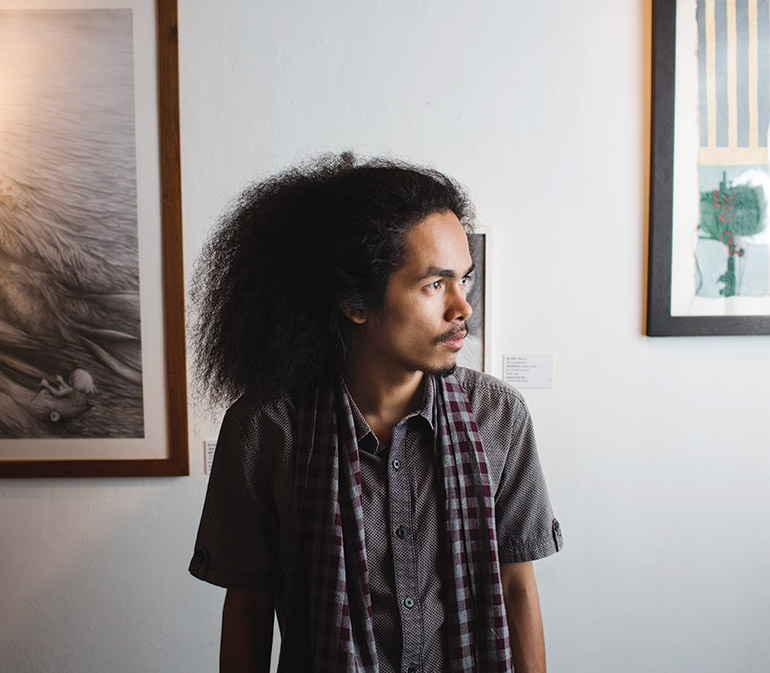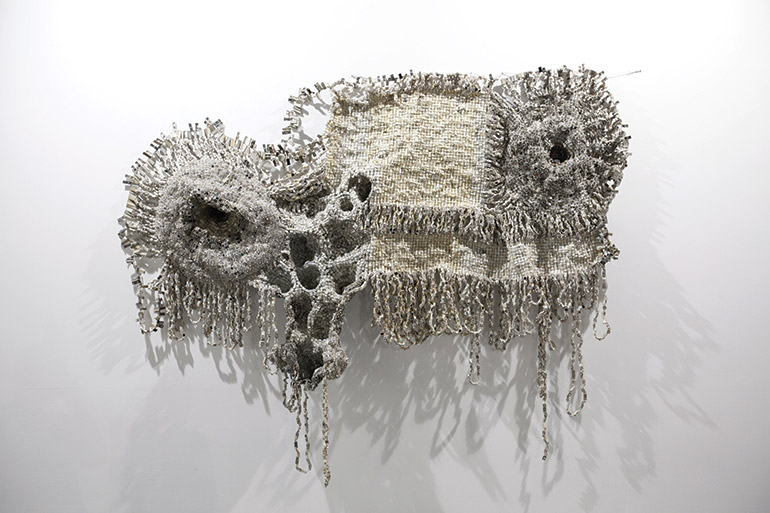Beneath a heavy black curtain in a darkened room, behind a bare wooden door dense with Javanese script, a demon is eating the sun. Wrought in ancient lettering, the door’s design depicts the first contact between native Americans and Christopher Columbus – a precursor to centuries of genocide and degradation in the unbridled pursuit of profit. Beneath it, the Javanese god of time and destruction devours the sun in a frenzied splash of black and green.
This installation piece, titled “Immortality”, is the work of Eddy Susanto, one of Southeast Asia’s most promising artists, who was featured at the Collector’s Stage at this year’s Art Stage Singapore. Part of Singapore-based collector Hady Ang’s trilogy PIGS (Politics, Immortality and Gods), the work is both a cutting critique of capitalism’s exploitation of traditional cultures and – within the confines of an exhibition defined by commercial wealth – a living example of its endurance.
As Southeast Asia’s contemporary art becomes increasingly desirable to collectors across the region and beyond, these individuals have begun to play an increasingly dominant role in a scene that still struggles to find other means of support.
Enin Supriyanto, the curator of the 2017 Collector’s Stage, said the show was a way to push significant works – that may otherwise have remained locked away by those with the wealth and capital to snap up some of Southeast Asia’s most desirable artworks into the public eye.
“We don’t even have proper public art and cultural institutions [in Southeast Asia],” he told Southeast Asia Globe. “How can the public enjoy these works if they all end up in private collections?”
In a region where contemporary art has played an important role in drawing attention to histories often ravaged by colonialism, autocracy and commercial interests, the public display and support of art that casts a critical eye on social issues is contentious.
For Eric Bunnag Booth, co-founder of Chiang Mai’s privately owned MAIIAM Contemporary Art Museum and an avid collector of Thai art for over 25 years, contemporary art is one of the few remaining avenues of critique under Thailand’s military junta, which has consistently cracked down on free speech.
“When I collect art it’s not the beautiful flower, that thing to decorate your living room,” he said. “Some of the artists which I’ve truly enjoyed were using art as a way to ask questions about everyday life – politics, the economy, social aspects of the different people from the city, the countryside – that’s what I enjoy a lot.”
According to Supriyanto, it is this power of art – to hold up a mirror to society’s shortcomings – that is in danger of being lost when artworks waste away in private hands.

“Contemporary art is a reflection of social and cultural issues that happen around us,” he said. “That means the accumulation of wealth also equals the accumulation of knowledge and information. We have to find a way that this knowledge and information can be shared.”
For many artists across the region, though, the grim world of the gavel is the only chance they have of sustaining their life’s work. Charlotte Galloway, a senior lecturer in Asian art history and curatorial studies at the Australian National University, said private collectors play an essential role in supporting artists in countries where arts funding is almost non-existent.
“We know artists don’t really make a lot of money, and it’s very hard for people in many Southeast Asian countries to sustain any sort of living as practising artists because there is a lack of public support,” she said. “So from that point of view [collecting is] terrific.”
In Phnom Penh, contemporary artists often lack spaces and support for their work. This prompted Cambodian curator Yean Reaksmey and Dana Langlois, art director of local artspace Java Café and Gallery, to organise one of Cambodia’s first public displays of works from the Kingdom’s elusive art collectors. Featuring works from historic and contemporary artists such as Svay Ken, Sopheap Pich and Oeur Sokuntevy, the exhibition, entitled The Object(s) of Collecting, is a sprawling meditation on the at-times intimate relationship between painter and patron.
Working with 22 Cambodian art collectors with backgrounds ranging from classical dance choreographers to ruling party politicians, Reaksmey said he was surprised to discover the extent to which local collectors were invested in the arts. “My own knowledge of the collectors was mostly of foreigners,” he said. “There were very few Cambodians that I knew as collectors – I never realised the scale of it.”
Kim Hak, a collector and photographer from Cambodia’s art capital of Battambang, said collectors often find themselves providing much-needed patronage for the nation’s close-knit artist community.
“In Cambodia, we don’t really have public funding for artists – the artists themselves struggle a lot,” he said. “When we have an exhibition and the artwork is sold, it’s a form of support for the artists and their creations.”
Langlois, who has worked with Cambodian artists for almost 20 years, said private patronage was critical to the nation’s arts community.
“It’s one of the particular challenges that we face as an arts community in Cambodia – there’s almost no funding whatsoever, or extremely little,” she said. “It’s still in its very early stages, and even corporate ownership or corporate sponsorship is very limited.”
Booth said there is always a delicate balance for artists in pursuing their own vision and pushing their work onto the market.
There’s always an impact with some kinds of works that sell very well, people want to repeat that again”
“They have to think about their families,” he said. “Without this network of supporters, or collectors, these people may well give up. If there’s a strong art market with collectors, galleries, art critics and artists, it creates – I hate to talk about dollars, but you need this art market so everybody survives and grows.”
In parts of Southeast Asia, the rush for the region’s artwork often pushes artists into a position of dependence that sometimes does little to encourage freedom of artistic expression. The downside of much of this patronage, Galloway said, was making artists reliant on the whims and wishes of individual collectors.
“The negative is then, of course, that the art market is being presented with objects [and] material publicly that is primarily determined by the interests of those private supporters,” she said. “So it’s sort of a process of selection there that depends on relationships between artists and patrons, essentially.”
Sutthirat ‘Som’ Supaparinya, a Thai visual artist and the director of Chiang Mai’s Asian Culture Station, said the demands of the market could often influence an artist’s work.
“There’s always an impact,” she said. “With some kinds of works that sell very well, people want to repeat that again. Some artists who usually work on installation pieces may be influenced to produce more object-based work in order to sell – there’s a really small market for digital work in Thailand.”
Drawing from her own curatorial work in Myanmar, Galloway described how many of the nation’s emerging artists appeared to be moulding their own work to suit the tastes of international collectors – often at the expense of traditional forms of art.

“There’s been quite dramatic changes in the type of artwork… being produced,” she said. “From more traditional painting, now we’re seeing much more installation work, sculptural work, which is not necessarily part of a traditional form of art practice. But… it’s a fine balancing act, because [the question is] are they making it to appeal to an international art market… or are they actually engaging with international art practice?”
Low Sze Wee, director of the curatorial and collections department at the newly minted National Gallery Singapore, said that while some collectors saw art as little more than a marker of their success, many had a genuine passion for contemporary work.
“Some definitely collect art as a form of status symbol, and therefore they collect work that attracts a lot of attention in the art market, but I think there are also other types of art patrons who are genuinely interested in supporting young artists and emerging artists,” he said. “Many times these types of artworks or art practices are not very collectible – I’m talking about installations, performance art – [and yet] they still attract a degree of support from contemporary arts patrons.”
Booth said he hoped that sharing his collection with the Thai public would encourage more people to invest in Thailand’s flourishing contemporary art scene.
“[Contemporary art] is, probably in Thailand, the only channel where you can express yourself and have discussions that are not, well, illegal,” he said. “From the beginning, something I’ve always been interested in is historical or cultural value. I really don’t invest, as in buy a piece of art, thinking that I will sell it for more money later.”
But with many of Southeast Asia’s state institutions outside of Singapore ill-equipped to accommodate the contemporary works littering the lobbies of the region’s high flyers, the pressure to accommodate the whims of private collectors is becoming difficult to ignore. For Supriyanto, this tension between public and private realms may just hold the key to a relationship that draws on the strengths – and shortcomings – of both.
“If the market situation and the [art] ecosystem are still working like what we have today in the next five, ten years, I don’t think any public institution can compete,” he said. “So these private collectors at the same time will start to face an issue – they have hundreds of thousands of works, and they don’t know what to do with them. They don’t know where to display them. It’s natural that these two different paths would start to communicate. They have to work together – otherwise it’s impossible.”


